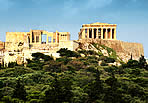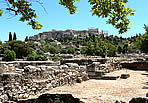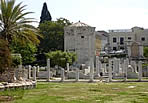Athens Acts 17:15-16, 22; 18:1; 1 Thessalonians 3:1
St. Paul's visit to the historic and adorned city of Athens marks
one of the most challenging parts of his career as a missionary and
Apostle. He arrived alone, while Silas and Timothy remained in
Macedonia. Though modern visitors are impressed with the great
buildings of the Acropolis and Olympian Zeus, the agora and the
impressive stoas, St. Paul was stirred by the idolatry of the city.
The history of this important center of philosophy and pagan
practice extends back millennia.
Neolithic remains (4000 BCE) have been found showing that the area
was inhabited well before the 6th century BCE. The name Athens stems
from the goddess Athena and is pluralized because it took in the
territory of a number of smaller villages. The focal point of the
city is the naturally raised platform Acropolis. In the early stages
of development, while other parts of the ancient Greek world rose to
spectacular levels of civilization, Athens was just one of many
city-states.
inhabited well before the 6th century BCE. The name Athens stems
from the goddess Athena and is pluralized because it took in the
territory of a number of smaller villages. The focal point of the
city is the naturally raised platform Acropolis. In the early stages
of development, while other parts of the ancient Greek world rose to
spectacular levels of civilization, Athens was just one of many
city-states.
Around 620 BCE, Draco, an Athenian aristocrat, initiated the first
steps towards order. His reputation for severity comes down to us in
the use of the term draconian (to indicate severe measures). The
legal system was further developed by another Athenian named Solon
who brought about constitutional reform as he allowed free elections
that involved all social classes, except slaves, in the process of
government.
After a period of tyrant rulers (Peisistratos and Sons), Athens grew
steadily greater, its independence threatened only by the Persian
King Darius in 490 BCE when they were defeated at Marathon, and
again by his son Xerxes (the King Ahasuerus of Esther 1-2) in 480 -
479 BCE when Athenians were forced to flee from their city before
defeating the Persians decisively at sea at Salamis, an island near
Piraeus. Despite the Athenians' victory, temples and monuments on
the Acropolis were destroyed by the Persians.
Under the ruler Pericles ("Golden age" of Athens) the Parthenon and
later the Propylaea and the Erechteion were built. With the Salamis
victory, Athens became the leading naval power of
 the
day, along with becoming the bastion of democracy and the center of
cultural and intellectual activity. This age saw such great minds as
Herodotus, the first Greek historian, Thucydides, who recorded the
events of the Peloponnesian War, and the great classical dramatists,
Aeschylus, Sophocles and Euripides, whose works were performed in
the Theater of Dionysus at the southern foot of the Acropolis.
the
day, along with becoming the bastion of democracy and the center of
cultural and intellectual activity. This age saw such great minds as
Herodotus, the first Greek historian, Thucydides, who recorded the
events of the Peloponnesian War, and the great classical dramatists,
Aeschylus, Sophocles and Euripides, whose works were performed in
the Theater of Dionysus at the southern foot of the Acropolis.
The greatness of the Athenian Empire was jealously watched by the
Spartans, and in 431 BCE, the Peloponnesian War began. It was to
last for thirty years, during which time Greece relapsed into chaos
with the collapse of Athens . Tyranny and political corruption set
in - humorously recorded during this period in the comedies of
Aristophanes.
From 370 BCE onwards, Athens began to make a recovery and soon
regained both its naval power and cultural, intellectual reputation
with such brilliant minds as Plato and Xenophon. The city came under
the rising power of Macedonia, and its citizens joined in the
conquests of Alexander the Great. Athens was specially regarded by
Alexander, whose Macedonian tutor, Aristotle taught at the Lyceum in
the city.
In 146 BCE, Athens fell under the rule of the rising western power
of the Romans who remained its master for over 500 years. The city
flourished under the patronage of some of the emperors (Hadrian),
but suffered looting of others (Nero). It was fashionable in the
earlier Roman world to be educated in Athens (Cicero and Horace) but
by 529 CE the Christian Roman Emperor Justinian decreed the schools
of philosophy to be closed. The emergence of Christianity caused the
downfall of the city's schools, although ironically, Greek was the
language of the new religion.
The concept of tourism also emerged during this period. Wealthy
Romans were keen travelers who loved the ancient classical world
which they attempted to emulate. They traveled widely in
 Greece,
reserving the best of their attention for Athens . A thriving trade
in antiques and works of art also developed as they were eagerly
sought after by the Romans for the decoration of their villas.
Greece,
reserving the best of their attention for Athens . A thriving trade
in antiques and works of art also developed as they were eagerly
sought after by the Romans for the decoration of their villas.
Under Byzantine domination, Athens diminished in importance. After
the fall of Constantinople to the Crusaders in 1204, Athens fell to
Boniface III Marquis of Monferrat as his share of the old Byzantine
Empire. The power of Frankish Greece was eventually destroyed by the
Catalans of Spain around 1311. After the rule of the Sicilians came
the Venetians, followed by four centuries of occupation by the Turks
from 1462.
In 1834, Athens became the capital of liberated Greece. During World
War I, the city was occupied by British and French troops, while in
World War II, suffered under German occupation. The modern city was
designed and constructed by Bavarian architects, since the first
king of Greece was the Bavarian Prince Otto.
The Plaka, near the Acropolis was designated to represent the "old
Athens ", and it survives with all the character, interest and
wonder that its long history attaches to it. The Plaka today
consists of a mixture of ancient Greek and Roman ruins, Byzantine
churches, Turkish mosques and nineteenth century houses.
The Agora was the central meeting place of ancient Athens . It was
both the market place and the heart of Athenian daily life. The Stoa
of Attalos, King of Pergamum , was built as a trading center in 159
BCE. It was reconstructed by the American School of Classical
Studies and houses finds from excavation in the area. To the east is the area of the Roman
Forum, begun in the reign of Julius Caesar and completed under
Hadrian.
from excavation in the area. To the east is the area of the Roman
Forum, begun in the reign of Julius Caesar and completed under
Hadrian.
The Athenian Acropolis stands alone in its unique combination of
grandeur, beauty and historical associations. In Classical times the
Pantheanic Way ended in a ramp straight up, but the modern approach
is different. The Propylae, a monumental gateway designed by
Mnesicles to replace an earlier entrance, has its axis aligned to
that of the Parthenon. It provides the only example, before
Hellenistic times, of designing one building in direct relationship
to another. Built of Pentelic marble, it remained intact till the
13th century, after which it suffered extensive damage and altered
proportion from the Franks and Turks, as well as lightning strikes.
The Temple of Athena Nike was built in 427 BCE to commemorate the
victory of the Athenians over the Persians.
The Parthenon represents the culmination of the Doric style of
architecture. It was erected in 447 - 438 BCE as the cardinal
feature of Pericles plan. Ictinus was the architect an Pheidias
supervised the whole of the sculptures. In the sixth century BCE, it
was converted to a Christian Church. Under Justianian, it was first
dedicated to Saint Sophia (the Holy Wisdom), then to the Virgin
Mother of God (Theotokos); then as a cathedral of the Frankish
dukes, it followed the Latin rite. During the Ottoman occupation it
became a mosque and was destroyed by the Venetians in the
seventeenth century. The Erechteion is the most original specimen of
Greek architecture. A joint shrine of Athena and Poseidon Erechteus
was finished after 395 BCE, and owes its curious plan to the
sacrosanct nature of the sanctuaries that preceded it. Like the
Parthenon it became known by a name that originally applied only to
one of its parts.
The Kerameikos includes the ruins of the Dipylon and Sacred Gates.
Here roads from Eleusis, Piraeus and Boetia converged upon that from
the Academy (Plato's Academy), so that by this way most ancient
travelers entered the city. Cemeteries existed in this area from the
12th century BCE. By the 7th century the inner area becomes a
quarter of potters and smiths and the outer, which is the cemetery,
is separated by the city wall. The Academy road outside the Gate
becomes the Demosion Sema, the cemetery reserved for state tombs and
cenotaps. It is here that Pericles delivered the famous oration (Thycydides).
The work of St. Paul in Athens left its mark with a few converts
including Damaris and Dionysus the Areopagite. In the succeeding
generations several important Christian thinkers rose from the
Athenian Church.
PLACE
REFERENCE
Amphipolis
Acts 17:1
Apollonia
Acts 17:1
Athens
Acts 17:15-16, 22; 18:1; 1 Thessalonians 3:1
Berea
Acts 17:10, 13: 20:4
Cenchrea
Acts 18:18, Romans 16:1
Coos (Kos)
Acts 21:1
Corinth
Acts 18:1; 19:1; 1 Corinthians 1:2; 2 Corinthians 1:1, 23; 2 Timothy
4:20
Cyprus
Acts 4:38; 11:19,20; 13:4; 15:39; 21:3,16; 27:4
Neapolis (Kavala) Acts 16:11
Patmos
Rev 1:9
Philippi Matthew 16:13; Mark 8:27; Acts 16:12, 22;
20:6; Philippians 1-4; 1 Thessalonians 2:2
Rhodes
Act 21:1
Thessalonica Acts
17:1. 11. 13; 27:2; Philippians 4:16: 1 and 2 Thessalonians; 2
Timothy 4:10


